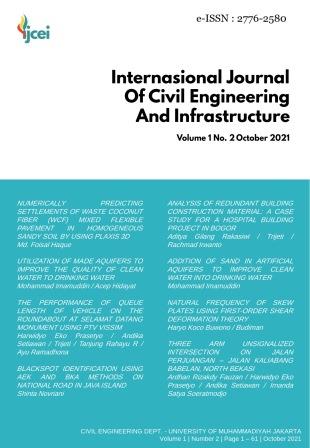BLACKSPOT IDENTIFICATION USING AEK AND BKA METHODS ON NATIONAL ROAD IN JAVA ISLAND
DOI:
https://doi.org/10.24853/ijcei.1.2.17-23Keywords:
blackspot, accident prone location, accident equivalent rate, BKAAbstract
Traffic accidents tend to increase and are still the main problem in the implementation of road transportation in Indonesia, especially on the island of Java. Based on the results of the population census, in 2016, 2017 and 2018 the average population on the island of Java reached 148 million people. As much as 56.1% of the total population in Indonesia is concentrated on the island of Java. This has an impact on increasing mobilization and the need for transportation so that traffic accidents tend to increase. Based on secondary data from the Korlantas Polri, the number of accidents increased by 5% from 2016 to 2018. The lack of handling and repairs in traffic accident-prone locations is one of the causes of frequent traffic accidents. Therefore, greater attention is needed on locations where traffic accidents often occur in order to reduce the number of traffic accidents every year. This study aims to identify LRK on national roads in Java with a frequency of 2 events per year, analyze the characteristics of accidents using the Accident Equivalent Rate and Upper Control Limit method. Data on victims of Death (D), Serious Injury (SI), Minor Injury (MI) and Material Losses (ML) in 2016, 2017 and 2018 were obtained from the Korlantas Polri. Based on these data, the AEK value is calculated and analyzed to obtain LRK using the BKA method. The results of the analysis show that the total LRK in Java is 1301 LRK in 2016, 1278 LRK in 2017 and 1309 LRK in 2018 so that there are 1296 LRK on average per year. Analysis of traffic accident data using the AEK and BKA methods in 2016 obtained the highest AEK value found in the province of East Java with an AEK value of 277024 events; Central Java with an AEK value of 183813 events and West Java with an AEK value of 139677 events, therefore there are 3 provinces with the highest number of Accident Prone Location (LRK) in Java, namely East Java, Central Java and West Java.References
Department of Infrastructure and Regional Development, Black Spot Sites Eligibility, Australian Government.
Department of Transport and Main Roads, Blackspot, Queensland Government.
Direktorat Jenderal Perhubungan Darat Satuan Kerja Direktorat Pembinaan Keselamatan, 2017, Penyusunan Penentuan Titik dan Rekomendasi Lokasi Rawan Kecelakaan (LRK) di Provinsi Sulawesi Tenggara, Kementerian Perhubungan.
Direktorat Jenderal Perhubungan Darat Satuan Kerja Direktorat Pembinaan Keselamatan, 2017, Penyusunan Penentuan Titik dan Rekomendasi Lokasi Rawan Kecelakaan (LRK) di Provinsi Sumatera Utara, Kementerian Perhubungan.
Forum Studi Transportasi antar Perguruan Tinggi Simposium dan International Symposium The Science for Developing Countries, 2019, Analisis Prioritas Penanganan Blackspot.
General Directorate of Highways, 2001, Road Improvement And Traffic Safety Project: Traffic Safety Project: Black Spot Manual, Sweroad.
Institute for Road Safety Research SWOV, 1982, Detection and Analysis of Black Spots With Even Small Accident Figures, Leidschendam, Netherlands.
Korps Lalu Lintas Kepolisian Negara Republik Indonesia, 2016, 2017, 2018.
Muslim, Akbar Adhitya. 2018. Analisis Lokasi Rawan Kecelakaan Lalu Lintas dan Penanganannya di Jalan Tol Ir. Wiyoto Wiyono, M.Sc Jakarta. Universitas Gadjah Mada.
Pedoman Konstruksi dan Bangunan. Pd T-09-2004-B. Penanganan Lokasi Rawan Kecelakaan Lalu Lintas. Departemen Permukiman Dan Prasarana Wilayah.
Peraturan Pemerintah Republik Indonesia No. 43 Tahun 1993 Tentang Prasarana Dan Lalu Lintas Jalan.
Sari, RR., Amarullah,M., Kristiyanti, N. 2017. Penentuan Titik Rawan Kecelakaan (Blackspot) Berdasarkan Angka Ekuivalen Kecelakaan Pada Ruas Jalan PH. H Mustofa – AH. Nasution Di Kota Bandung. Industrial Research Workshop and Nastional Seminar. Politeknik Negeri Bandung. Juli 2017. 26-27.
Simanungkalit, H.M.T Rustxell P., Aswad, Yusandy. Analisa Faktor Penyebab Kecelakaan Lalu Lintas Di Ruas Jalan Sisingamaraja (STA 00+000 – STA 10+000) Kota Medan. Jurnal Universitas Sumatera Utara.
Soemantri, SPA. 2012. Evaluasi Kondisi Geometri di Ruas Jalan Nasional Yang Berpotensi Sebagai Lokasi Rawan Kecelakaan.
Sugiyanto,G., Fadli, A. 2017. Identifikasi Lokasi Rawan Kecelakaan Lalu Lintas Dengan Metode Batas Kontrol Atas dan Upper Control Limit. Jurnal Teknik Sipil. Universitas Jenderal Soedirman Purwokerto.
Susilo, B. H. (2014). Buku Panduan Praktis Keselamatan Lalu Lintas Jalan. Bandung: Penerbit Pusat Studi Transportasi Antar Disiplin Ilmu Universitas Kristen Maranatha.
Susilo, B.H., 2014. Dasar-Dasar Rekayasa Transportasi, Universitas Trisakti Jakarta.
Susilo, BH., Cahyadi, LW. 2018. Prioritas Penanganan Lokasi Rawan Kecelakaan (LRK) Di Provinsi Sumatera Utara. Jurnal Teknik Sipil. Vol 14 No. 1 April 2018 : 1-104.
Transport Research Laboratory (TRL), 1994. Accident Blackspot Investigation, Crowthorne Berkshire, United Kingdom.
Undang-Undang Republik Indonesia Nomor 38 Tahun 2004 Tentang Jalan.
Undang-Undang Republik Indonesia Nomor 22 Tahun 2009 tentang Lalu Lintas Angkutan Jalan.
World Health Organization, 2009. Peringkat Penyebab Kematian di Dunia Tahun 2004 – 2030.

